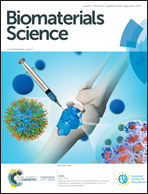Trifluoromethyl-functionalized poly(lactic acid): a fluoropolyester designed for blood contact applications†
Abstract
Fluorinated polymers are strong candidates for development of new cardiovascular medical devices, due to their lower thrombogenicity as compared to other polymers used for cardiovascular implants. Few studies have reported the development of fluorinated polyesters and their potential in blood contact applications has never been examined. In this study, we developed a versatile method for preparing trifluoromethyl-functionalized poly(lactic acid) that can be potentially extended to prepare a new class of polyesters with various halogen or halocarbon substitutions. The resulting fluorinated polymer was hydrophobic relative to poly(lactic acid) and extracts from this polymer showed no in vitro cytotoxicity to NIH-3T3 mouse fibroblast cells. A preliminary consideration of the blood interactions of the CF3-functionalized polyester was evaluated by measuring the amount of the adsorbed albumin and fibrinogen from human blood plasma. The fluorinated polyester adsorbed and retained higher amounts of albumin and fibrinogen with a higher albumin/fibrinogen ratio as compared to poly(lactic acid), suggesting enhanced hemocompatibility. Plasma protein adsorption is the first event that occurs seconds after device implantation and controlling the adsorbed proteins will dictate the performance of medical implants.



 Please wait while we load your content...
Please wait while we load your content...
